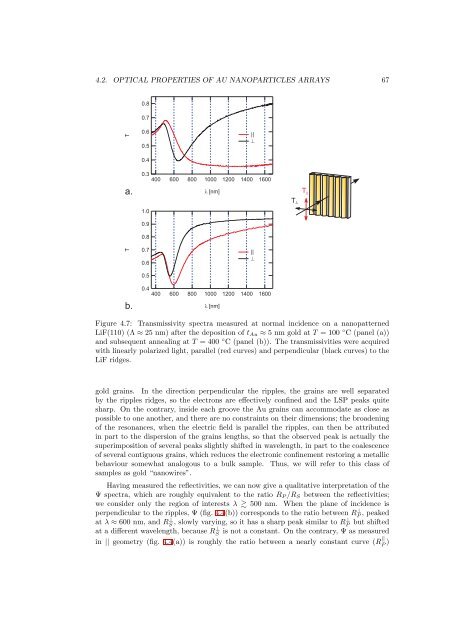Morphology and plasmonic properties of self-organized arrays of ...
Morphology and plasmonic properties of self-organized arrays of ...
Morphology and plasmonic properties of self-organized arrays of ...
Create successful ePaper yourself
Turn your PDF publications into a flip-book with our unique Google optimized e-Paper software.
4.2. OPTICAL PROPERTIES OF AU NANOPARTICLES ARRAYS 670.80.7T0.60.5||0.4a.0.34006008001000 [nm]120014001600T ||1.0T ┴0.90.8T0.70.6||0.5b.0.44006008001000 [nm]120014001600Figure 4.7: Transmissivity spectra measured at normal incidence on a nanopatternedLiF(110) (Λ ≈ 25 nm) after the deposition <strong>of</strong> t Au ≈ 5 nm gold at T = 100 ◦ C (panel (a))<strong>and</strong> subsequent annealing at T = 400 ◦ C (panel (b)). The transmissivities were acquiredwith linearly polarized light, parallel (red curves) <strong>and</strong> perpendicular (black curves) to theLiF ridges.gold grains. In the direction perpendicular the ripples, the grains are well separatedby the ripples ridges, so the electrons are effectively confined <strong>and</strong> the LSP peaks quitesharp. On the contrary, inside each groove the Au grains can accommodate as close aspossible to one another, <strong>and</strong> there are no constraints on their dimensions; the broadening<strong>of</strong> the resonances, when the electric field is parallel the ripples, can then be attributedin part to the dispersion <strong>of</strong> the grains lengths, so that the observed peak is actually thesuperimposition <strong>of</strong> several peaks slightly shifted in wavelength, in part to the coalescence<strong>of</strong> several contiguous grains, which reduces the electronic confinement restoring a metallicbehaviour somewhat analogous to a bulk sample. Thus, we will refer to this class <strong>of</strong>samples as gold “nanowires”.Having measured the reflectivities, we can now give a qualitative interpretation <strong>of</strong> theΨ spectra, which are roughly equivalent to the ratio R P /R S between the reflectivities;we consider only the region <strong>of</strong> interests λ 500 nm. When the plane <strong>of</strong> incidence isperpendicular to the ripples, Ψ (fig. 4.4(b)) corresponds to the ratio between RP ⊥, peakedat λ ≈ 600 nm, <strong>and</strong> RS ⊥, slowly varying, so it has a sharp peak similar to R⊥ P but shiftedat a different wavelength, because RS ⊥ is not a constant. On the contrary, Ψ as measuredin || geometry (fig. 4.4(a)) is roughly the ratio between a nearly constant curve (R || P )
















